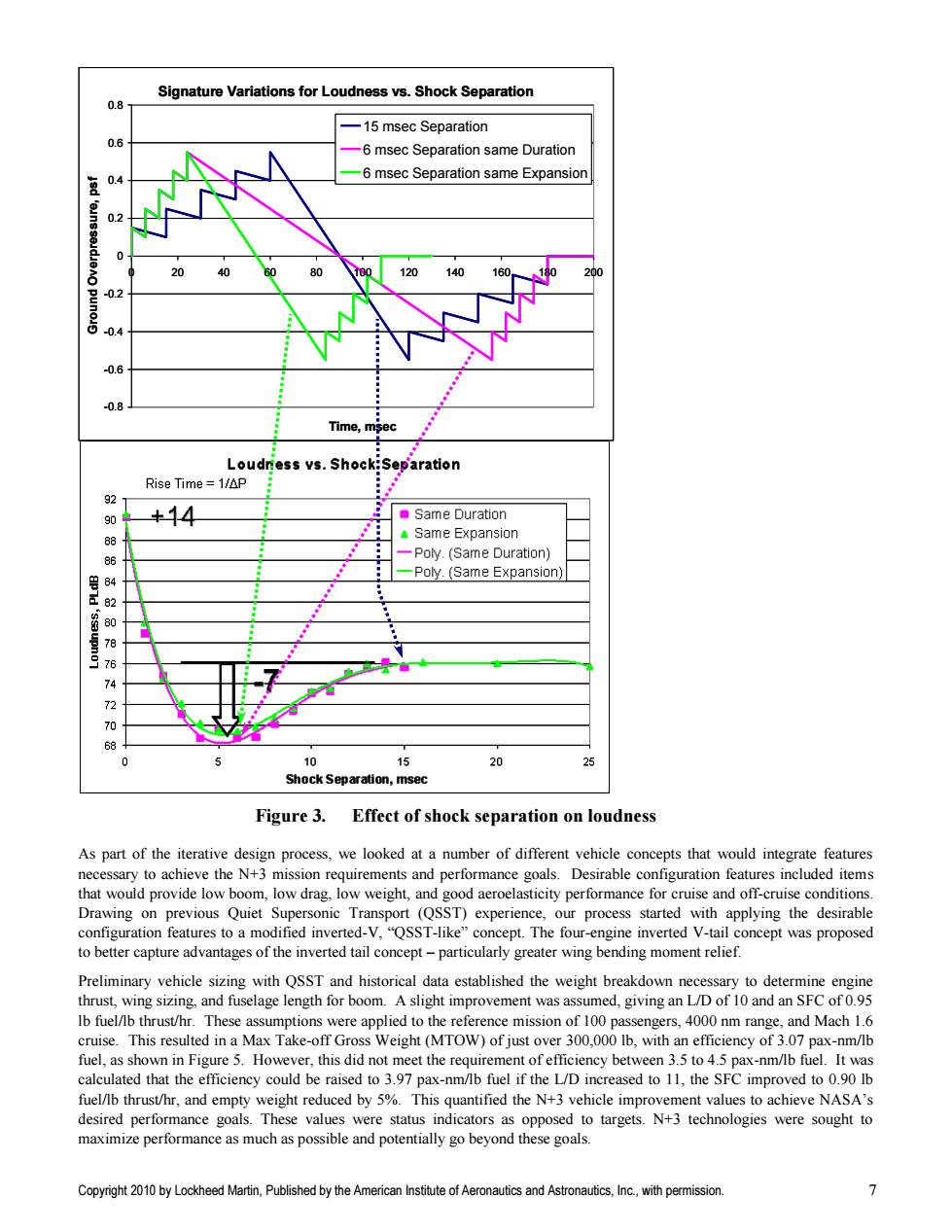正在加载图片...

Signature Variations for Loudness vs.Shock Separation 0.8 -15 msec Separation 0.6 -6 msec Separation same Duration 0.4 -6 msec Separation same Expansion 02 30 120 140 160 200 -0.2 -0.4 0.6 -0.8 Time,msec Loudriess vs.Shock:Separation Rise Time =1/AP +14 ■Same Duration Same Expansion 8 Poly.(Same Duration) -Poly.(Same Expansion) 8p7d 'ssaupno] 20364208 10 20 25 Shock Separation,msec Figure 3. Effect of shock separation on loudness As part of the iterative design process,we looked at a number of different vehicle concepts that would integrate features necessary to achieve the N+3 mission requirements and performance goals.Desirable configuration features included items that would provide low boom,low drag,low weight,and good aeroelasticity performance for cruise and off-cruise conditions. Drawing on previous Quiet Supersonic Transport (QSST)experience,our process started with applying the desirable configuration features to a modified inverted-V,"QSST-like"concept.The four-engine inverted V-tail concept was proposed to better capture advantages of the inverted tail concept-particularly greater wing bending moment relief. Preliminary vehicle sizing with QSST and historical data established the weight breakdown necessary to determine engine thrust,wing sizing,and fuselage length for boom.A slight improvement was assumed,giving an L/D of 10 and an SFC of 0.95 Ib fuel/lb thrust/hr.These assumptions were applied to the reference mission of 100 passengers,4000 nm range,and Mach 1.6 cruise.This resulted in a Max Take-off Gross Weight(MTOW)of just over 300,000 Ib,with an efficiency of 3.07 pax-nm/Ib fuel,as shown in Figure 5.However,this did not meet the requirement of efficiency between 3.5 to 4.5 pax-nm/lb fuel.It was calculated that the efficiency could be raised to 3.97 pax-nm/lb fuel if the L/D increased to 11,the SFC improved to 0.90 Ib fuel/lb thrust/hr,and empty weight reduced by 5%.This quantified the N+3 vehicle improvement values to achieve NASA's desired performance goals.These values were status indicators as opposed to targets.N+3 technologies were sought to maximize performance as much as possible and potentially go beyond these goals. Copyright 2010 by Lockheed Martin,Published by the American Institute of Aeronautics and Astronautics,Inc.,with permission. 7Copyright 2010 by Lockheed Martin, Published by the American Institute of Aeronautics and Astronautics, Inc., with permission. 7 Signature Variations for Loudness vs. Shock Separation -0.8 -0.6 -0.4 -0.2 0 0.2 0.4 0.6 0.8 0 20 40 60 80 100 120 140 160 180 200 Time, msec Ground Overpressure, psf 15 msec Separation 6 msec Separation same Duration 6 msec Separation same Expansion Signature Variations for Loudness vs. Shock Separation -0.8 -0.6 -0.4 -0.2 0 0.2 0.4 0.6 0.8 0 20 40 60 80 100 120 140 160 180 200 Time, msec Ground Overpressure, psf 15 msec Separation 6 msec Separation same Duration 6 msec Separation same Expansion Figure 3. Effect of shock separation on loudness As part of the iterative design process, we looked at a number of different vehicle concepts that would integrate features necessary to achieve the N+3 mission requirements and performance goals. Desirable configuration features included items that would provide low boom, low drag, low weight, and good aeroelasticity performance for cruise and off-cruise conditions. Drawing on previous Quiet Supersonic Transport (QSST) experience, our process started with applying the desirable configuration features to a modified inverted-V, ―QSST-like‖ concept. The four-engine inverted V-tail concept was proposed to better capture advantages of the inverted tail concept – particularly greater wing bending moment relief. Preliminary vehicle sizing with QSST and historical data established the weight breakdown necessary to determine engine thrust, wing sizing, and fuselage length for boom. A slight improvement was assumed, giving an L/D of 10 and an SFC of 0.95 lb fuel/lb thrust/hr. These assumptions were applied to the reference mission of 100 passengers, 4000 nm range, and Mach 1.6 cruise. This resulted in a Max Take-off Gross Weight (MTOW) of just over 300,000 lb, with an efficiency of 3.07 pax-nm/lb fuel, as shown in Figure 5. However, this did not meet the requirement of efficiency between 3.5 to 4.5 pax-nm/lb fuel. It was calculated that the efficiency could be raised to 3.97 pax-nm/lb fuel if the L/D increased to 11, the SFC improved to 0.90 lb fuel/lb thrust/hr, and empty weight reduced by 5%. This quantified the N+3 vehicle improvement values to achieve NASA‘s desired performance goals. These values were status indicators as opposed to targets. N+3 technologies were sought to maximize performance as much as possible and potentially go beyond these goals